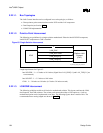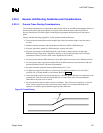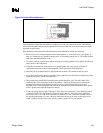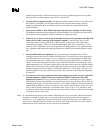
Intel
®
820E Chipset
R
108 Design Guide
2.22.2.1.1. Trace Geometry and Length
The key factors in controlling trace EMI radiation are the trace length and the ratio of trace width to trace
height above the ground plane. To minimize trace inductance, high-speed signals and signal layers close
to a ground or power plane should be as short and wide as practical. Ideally, this ratio of trace width to
height above ground plane should be between 1:1 and 3:1. To maintain trace impedance, the trace width
should be modified when changing from one board layer to another, if the two layers are not equidistant
from the power or ground plane. Differential trace impedances should be controlled at approximately
100 Ω. It is necessary to compensate for trace-to-trace edge coupling, which can lower the differential
impedance by 10 Ω, when the traces within a pair are closer than 0.030 inch (edge to edge).
Traces between decoupling and I/O filter capacitors should be as short and wide as practical. Long-and-
thin traces are more inductive and would reduce the intended effect of decoupling capacitors. For similar
reasons, traces to I/O signals and signal terminations should be as short as possible. Vias to the
decoupling capacitors should be sufficiently large in diameter to decrease series inductance.
2.22.2.1.2. Signal Isolation
Signal isolation rules include the following:
• If possible, separate and group signals by function on separate layers. Maintain a gap of 100 mils
between all differential pairs (phone line and Ethernet) and other nets, but group associated
differential pairs. Note: Over the length of a trace run, each differential pair should be at least
0.3 inch from any parallel signal trace.
• Physically group all components associated with one clock trace, to reduce the trace length and
radiation.
• Isolate I/O signals from high-speed signals to minimize crosstalk, which can increase EMI emission
and susceptibility to EMI from other signals.
• Avoid routing high-speed LAN or phone line traces near other high-frequency signals associated
with a video controller, cache controller, processor or similar device.
2.22.2.2. Power and Ground Connections
Rules and guidelines for power and ground connections include the following:
• All V
CC
pins should be connected to the same power supply.
• All V
SS
pins should be connected to the same ground plane.
• Four to six decoupling capacitors, including two 4.7 µF capacitors are recommended.
• Place decoupling as close as possible to power pins.
2.22.2.2.1. General Power and Ground Plane Considerations
To properly implement the common-mode choke functionality of the magnetics module, the chassis or
output ground (secondary side of transformer) should be physically separated from the digital or input
ground (primary side) by at least 100 mils.


















